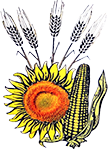Chemical Control of Invasive Species Sorghum Halepense (L.) Pers. in Maize Agroecosystem
Marga Grădilă1, Valentin Marius Ciontu1, Raluca Monica Cristea1, Șerban Mihaela2, Victor Petcu2,3, Daniel Jalobă1
1Institutul de Cercetare-Dezvoltare pentru Protecția Plantelor București
2Institutul Național de Cercetare Dezvoltare Agricolă Fundulea
3Centrul de Studii și Cercetări de Biodiversitate Agrosilvică "Acad. David Davidescu", București
Keywords: Johnsongras, invasive species, maize, herbicides.
Abstract: Agroecosystems are vulnerable to the danger posed by invasive weed species, as they threaten not only natural habitats but also native weed associations of farmland. In recent years in Romania, it has been found that certain invasive weed species have a strong effect of transforming the segetal weed communities in agroecosystems. One such species is Sorghum halepense (Johnsongras), a perennial plants that multiplies by seeds but especially vegetatively by rhizomes and which in favorable conditions of growth and development causes a decrease in the density and diversity of the flora in the maize agroecosystems that it invades, becoming dominant. S. halepense (Family Poaceae), is among the most persistent weeds in the world being distributed over a third of the total global surface, causing significant losses to agriculture and natural biodiversity. It is ranked as the sixth most noxious weed in the world, infesting 30 different crops in 53 countries and is widely naturalized over millions of hectares globally. By its biological nature, corn plants are characterized as lacking the ability to compete with weeds, especially in the early stages of vegetation. Slow growth of corn plants in the first 4-6 weeks after emergence, associated with a low density (4-6 plant/m2), creates a major advantage in the competition since the beginning in favor of weeds. Therefore, management strategies integrated are necessary to reduce the susceptibility of maize agroecosystems to invasion while maintaining their sustainability. One of the integrated management practices consists in the use of herbicides, which are considered to be the most effective method of control invasive weeds. In this context, the paper presents aspects regarding the chemical control of invasive species S. halepense in maize agroecosystems.
